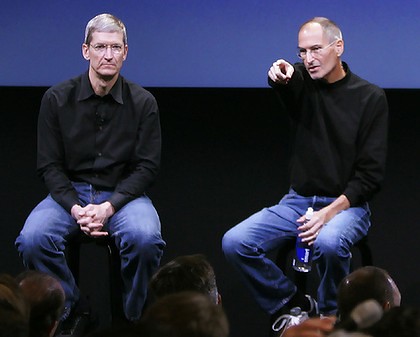I was lucky enough to get an advanced copy of Adam Lashinsky’s new book Inside Apple (available now on Amazon as an e-book) and, suffice it to say, it’s chock full of new and interesting information that Apple fans will find of utmost interest.
And especially because Apple is a notoriously secretive company, sometimes even the most mundane of details about how the company works are shrouded in mystery, and therefore, intrigue.
A few months back, Lashinsky wrote an article for Fortune where he described, somewhat briefly, a typically-annual Apple gathering dubbed the “Top 100”. The gathering was/is comprised of the 100 employees Steve Jobs would take with him in the hypothetical scenario where he’d be forced to branch off and start anew. In other words, the best of the best.
 Naturally, being chosen to attend the Top 100 gathering was an honor and an extremely coveted distinction. The individuals chosen for the gathering weren’t necessarily all high-ranking executives as low level engineers would sometimes be chosen at the expense of certain department VPs.
Naturally, being chosen to attend the Top 100 gathering was an honor and an extremely coveted distinction. The individuals chosen for the gathering weren’t necessarily all high-ranking executives as low level engineers would sometimes be chosen at the expense of certain department VPs.
“Hurt feelings over exclusion were the norm, which is what Jobs expected and even relished,” Lashinsky writes.
As you might expect from a company like Apple, the Top 100 gathering was “shrouded in secrecy”, with Apple going so far as to institute a rule that prevented attendees from driving themselves. Rather, they had to drive to a pickup point and hop on a bus to the destination point, which for many years was the Chaminade Resort & Spa in Santa Cruz, California before it was moved to the Carmel Valley Ranch in recent years.
So secretive were the details of the Top 100 meeting that Apple had the meeting rooms swept for bugs beforehand. Jobs was known to forbid food servers from entering the room while products were being shown. He once encouraged attendees to introduce themselves to the person sitting next to them to ensure that no one had snuck into the room.
Wow, it’s surprising he didn’t have special employees taste the food to check for poison!
Once all the over-the-top security measures were taken care of, Jobs was able to get down to business.
Once ensconced at their exclusive off-site, the Top 100 were treated to a thorough review of Apple’s product plans for the next eighteen months or so. Jobs sat at the front of the room, kicking things off with a presentation that described his vision for the company and then presiding over presentations by other executives.
Highlighting the seriousness to which Jobs took these meetings, his presentations were said to be as informative and as serious as his famous keynote presentations. Each day, there’d be about 6 presentations from Jobs and his executive crew, each coming in at about 1 hour long.
One executive recalled how nothing in those meetings was off-limits. Whereas Apple typically exerts control over the narrative behind its products, the Top 100 meeting provided an avenue where employees could discuss and debate anything they wanted without having to worry about secrecy or repercussions from questioning the powers that be.
The meetings were intended to allow the level of leadership below the executive team – people who in such a siloed and segregated company wouldn’t ordinarily interact with one another – to bond.
Tantalizingly, the Top 100 meeting also served as an opportunity for Apple to reveal upcoming products to the lucky employees in attendance.
Lashinsky notes, for example, that Apple’s retail plans along with the original iPod were both unveiled at these Top 100 meetings long before being introduced to the public. While this might not seem all that surprising, remember that secrecy at Apple is paramount and that the company has security measures in place to ensure that the only employees aware of an upcoming product are the ones working on it.
Sidenote: Given the tepid response to Jobs’ original iPod introduction, we wonder what the folks at the Top 100 thought about Apple’s first music player
Lashinsky notes that the last Top 100 retreat attended by Jobs was in November 2010 where the big reveal was the iPad 2, complete with the ingenious smart cover. This was a solid 4 months before the official iPad 2 announcement.
Products aside, the Top 100 meeting also provided Apple employees unfettered access to Jobs and his cadre of trusted executives in the form of a Q&A session. In once instance, Jobs was asked why he wasn’t more philanthropic. In classic Jobs form, he bluntly responded that it was a waste of time.
In another portion of the book, Lashinksy noted that Jobs’ goal was to create value in Apple as a company so that shareholders could accumulate wealth and give it away at their own discretion.
Jobs was notoriously stingy when it came to giving away money. He argued privately that the most philanthropic action Apple could take was to increase the value of the company to share-holders could give away their wealth to causes of their choice, not Apple’s.
Interestingly, the Top 100 wasn’t always and exclusively comprised of Apple employees. Every so often, an executive from another company would be invited along, such as Intel CEO Paul Otellini and some of Apple’s “key contacts at AT&T.”
Lastly, and somewhat comically, one former Apple manager said that many employees who weren’t invited along to the retreat would indulge themselves in a “tounge-in-cheek” Bottom 100 lunch while the chosen few were out getting a glimpse of the future with Jobs and co.





Wed, Jan 25, 2012
Featured